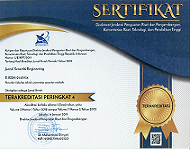Pengaruh Aerasi pada Elektroda Seng dengan Tanaman Typha latifolia dalam Sistem CW-MFC terhadap Penurunan Parameter Pencemar Air Lindi TPA
Keywords:
Lindi, CW-MFC, Typha latifolia, Elektroda, COD, TNAbstract
Leachate is a complex wastewater with high organic and nutrient content that poses a significant risk of environmental pollution if not properly treated. One of the promising approaches is the Constructed Wetland–Microbial Fuel Cell (CW-MFC) system, which integrates plant and microbial biological processes with electrode utilization to simultaneously treat pollutants and generate electricity. This study employed Typha latifolia with zinc (Zn) electrodes and aeration treatments to evaluate the effectiveness of the system in reducing pollutants and producing bioelectricity. The observed parameters included COD, Total Nitrogen (TN), as well as voltage, current, and power output. The results showed that zinc electrodes achieved COD removal efficiency up to 95% and TN removal up to 88% at the optimal retention time, although a decline was observed on day 16 due to microbial saturation and root exudate release. Statistical analysis revealed that the type of electrode had a significant effect on voltage generation (p-value = 0.006), while aeration and retention time did not show significant effects on electricity production. In conclusion, the CW-MFC system with zinc electrodes and Typha latifolia has great potential as an alternative technology for leachate treatment while simultaneously generating environmentally friendly electricity.
References
[1] I. K. Erabee and S. Ethaib, “Treatment of contaminated landfill leachate using aged refuse biofilter medium,” Oriental Journal of Chemistry, vol. 34, no. 3, pp. 1441–1450, 2018, doi: 10.13005/ojc/340334.
[2] C. Teng, K. Zhou, C. Peng, and W. Chen, “Characterization and treatment of landfill leachate: A review,” Water Res, vol. 203, Sep. 2021, doi: 10.1016/j.watres.2021.117525.
[3] P. Srivastava, A. K. Yadav, V. Garaniya, and R. Abbassi, “Constructed wetland coupled microbial fuel cell technology: Development and potential applications,” in Biomass, Biofuels, Biochemicals: Microbial Electrochemical Technology: Sustainable Platform for Fuels, Chemicals and Remediation, Elsevier, 2018, pp. 1021–1036. doi: 10.1016/B978-0-444-64052-9.00042-X.
[4] P. N. Karungamye, “Potential of Canna indica in Constructed Wetlands for Wastewater Treatment: A Review,” Conservation, vol. 2, no. 3, pp. 499–513, Aug. 2022, doi: 10.3390/conservation2030034.
[5] D. Cahyani, A. Haryanto, D. S. Marpaung, and R. Fil’aini, “Sel Bahan Bakar Berbasis Mikroba-Tanaman (P-MFC) Sebagai Sumber Energi Listrik; Prinsip Kerja, Variasi Desain, Potensi dan Tantangan,” Jurnal Teknik Pertanian Lampung (Journal of Agricultural Engineering), vol. 9, no. 2, p. 112, Jun. 2020, doi: 10.23960/jtep-l.v9i2.112-121.
[6] R. A. Timmers, D. P. B. T. B. Strik, H. V. M. Hamelers, and C. J. N. Buisman, “Electricity generation by a novel design tubular plant microbial fuel cell,” Biomass Bioenergy, vol. 51, pp. 60–67, 2013, doi: https://doi.org/10.1016/j.biombioe.2013.01.002.
[7] K. Wetser, “Electricity from wetlands Technology assessment of the tubular Plant Microbial Fuel Cell with an integrated biocathode,” Wageningen University, 2016.
[8] M. O. Eze and C. F. Amuji, “Elucidating the significant roles of root exudates in organic pollutant biotransformation within the rhizosphere,” Sci Rep, vol. 14, no. 1, Dec. 2024, doi: 10.1038/s41598-024-53027-x.
[9] M. Narayan et al., “Optimizing COD removal, lignin degradation and electricity generation from pulp and paper industry wastewater by CW-MFC using box-behnken design,” Front Energy Res, vol. 13, 2025, doi: 10.3389/fenrg.2025.1549247.
[10] Setiawan, Didik, Mahardika Prasetya Aji, and Budi Astuti. "Pembuatan Elektroda Berbahan Air Cucian Beras." Prosiding Seminar Nasional Pascasarjana. Vol. 3. No. 1. 2020.
[11] A. Rizky Maulina, S. Hendriany, and U. Dwi Putri, “Potensi Microbial Fuel Cell (MFC) pada Mikroba Tanah Sawah Lumpur Dataran Tinggi,” in Prosiding SEMNASBIO 2024, 2024.
[12] M. A. D. Tama, Y. S. Purnomo, and S. Q. Z. Nisa, “Pengaruh Jenis Anoda Microbial Fuel Cells Terhadap Power Density Dan Penyisihan Kandungan Organik Limbah Cair Industri Tahu,” Jurnal Serambi Engineering, vol. IX, no. 4, 2024.
[13] Ç. Saz, C. Türe, O. C. Türker, and A. Yakar, “Effect of vegetation type on treatment performance and bioelectric production of constructed wetland modules combined with microbial fuel cell (CW-MFC) treating synthetic wastewater,” Environmental Science and Pollution Research, vol. 25, no. 9, pp. 8777–8792, Mar. 2018, doi: 10.1007/s11356-018-1208-y.
[14] H. R. Coker, H. A. Lin, C. E. B. Shackelford, M. M. Tfaily, A. P. Smith, and J. A. Howe, “Drought stimulates root exudation of organic nitrogen in cotton (Gossypium hirsutem),” Front Plant Sci, vol. 15, 2024, doi: 10.3389/fpls.2024.1431004.
[15] X. Wang, Y. Tian, H. Liu, X. Zhao, and Q. Wu, “Effects of influent COD/TN ratio on nitrogen removal in integrated constructed wetland–microbial fuel cell systems,” Bioresour Technol, vol. 271, pp. 492–495, Jan. 2019, doi: 10.1016/j.biortech.2018.09.039.
[16] C. Santoro, C. Arbizzani, B. Erable, and I. Ieropoulos, “Microbial fuel cells: From fundamentals to applications. A review,” J Power Sources, vol. 356, pp. 225–244, 2017, doi: 10.1016/j.jpowsour.2017.03.109.
Downloads
Published
Issue
Section
License
Copyright (c) 2025 Ramiza Firyal Tuffahati, Aussie Amalia (Author)

This work is licensed under a Creative Commons Attribution 4.0 International License.












